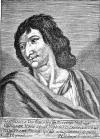Biography
Savinien de Cyrano de Bergerac was a French dramatist and duellist who is now best remembered for the many works of fiction which have been woven around his life story. In these fictional works he is featured with an overly large nose; portraits suggest that he did have a big nose, though not nearly as large as described in Edmond Rostand's play and the subsequent works about him. A statue of him stands in the town of Bergerac, Dordogne.
It is believed that around 1640 he became the lover of Charles Coypeau d'Assoucy, a writer and musician, until around 1653, when they became engaged in a bitter rivalry. This led to Bergerac sending d'Assoucy death threats that compelled him to leave Paris. The quarrel extended to a series of satirical texts by both men. Bergerac wrote Contre Soucidas (an anagram of his enemy's name) and Contre un ingrat ("Against an Ingrate"), while D?Assoucy counterattacked with Le Combat de Cyrano de Bergerac avec le singe, de Brioché au bout du Pont-Neuf ("The Battle of Cyrano de Bergerac with the Monkey of Brioché at the end of the Pont Neuf").
The model for the Roxane character of the Rostand play was Bergerac's cousin, who lived with his aunt, Catherine de Cyrano, at the Convent of the Daughter of the Cross, where Bergerac was tended for injuries sustained from a falling lunar beam. As in the play, Bergerac did fight at the siege of Arras (1640), a battle of the Thirty Years' War between French and Spanish forces in France (though this was not the more famous final Battle of Arras, fought fourteen years later). One of his confreres in the battle was the Baron of Neuvillette, who married Cyrano's cousin. However, the play's plotline involving Roxane and Christian is almost entirely fictional ? the real Cyrano did not write the Baron's love letters for him.
Cyrano was a freethinker and a pupil of Pierre Gassendi, a canon of the Catholic Church who tried to reconcile Epicurean atomism with Christianity. Cyrano's insistence on reason was rare in his time, and he would have been at home in the Enlightenment that came a century after his death.
He was injured by a falling wooden beam in 1654 while entering the house of his patron, the Duc D'Arpajon. Whether it was a deliberate attempt on his life or merely an accident is unknown. It is also inconclusive as to whether or not his death was a result of the injury, or an unspecified disease. He died over a year later on July 28, 1655 aged 36. His place of death was the house of his cousin, Pierre De Cyrano, in Sannois. He was buried in a Church in Sannois. ..






